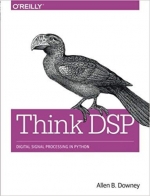Think DSP Digital Signal Processing in Python. Allen B. Downey

Категория: Python
Поделиться:
Signal processing is one of my favorite topics. It is useful in many areas of science and engineering, and if you understand the fundamental ideas, it provides insight into many things we see in the world, and especially the things we hear. But unless you studied electrical or mechanical engineering, you probably haven’t had a chance to learn about signal processing. The problem is that most books (and the classes that use them) present the material bottom-up, starting with mathematical abstractions like phasors. And they tend to be theoretical, with few applications and little apparent relevance. The premise of this book is that if you know how to program, you can use that skill to learn other things, and have fun doing it. With a programming-based approach, I can present the most important ideas right away. By the end of the first chapter, you can analyze sound recordings and other signals, and generate new sounds. Each chapter introduces a new technique and an application you can apply to real signals. At each step you learn how to use a technique first, and then how it works. This approach is more practical and, I hope you’ll agree, more fun.
Скачать
Комментарии